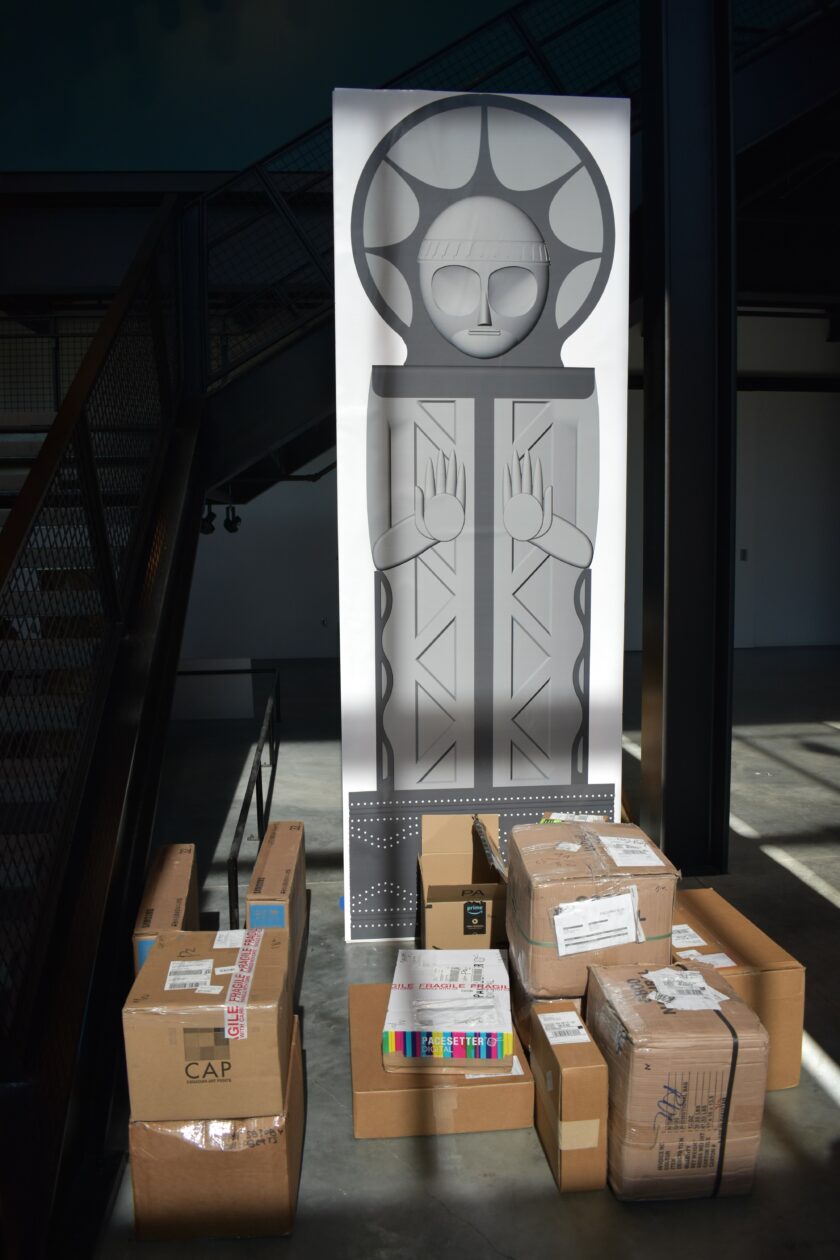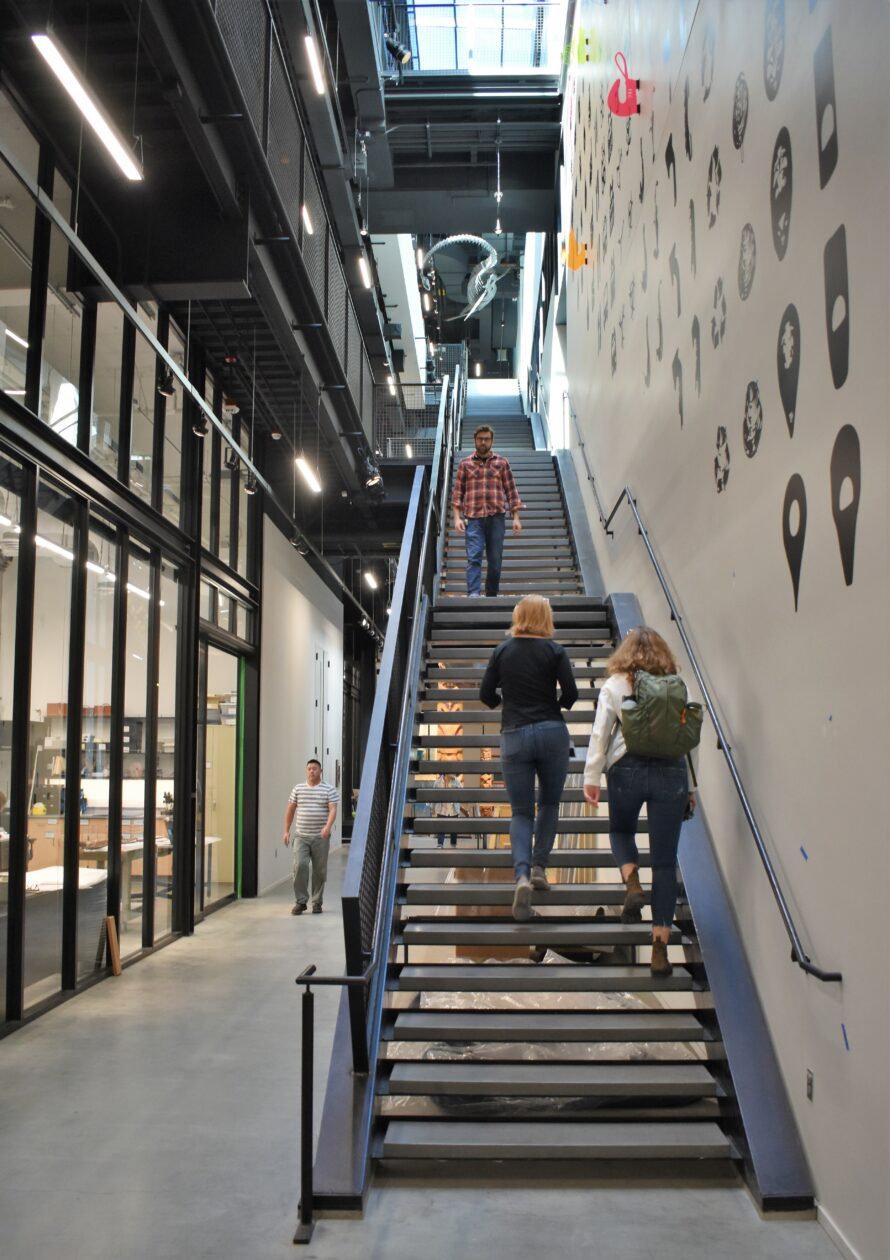
After a three-year, $99 million construction effort, the Burke Museum of Natural History and Culture is putting the finishing touches on a new home that shows off old favorites and a brand-new centerpiece for the ages: a 66 million-year-old T. rex skull that museum volunteers discovered in Montana in 2015.
“That skull is completely prepared and mounted — and the scariest thing I’ve ever seen,” the museum’s executive director, Julie Stein, told GeekWire.
But that’s not all: There’ll be other treasures on display, both scary and soulful.
The skeletons of a mastodon and a beaked whale, plus a gleaming glass monument done up in Coast Salish style, will greet visitors when they enter through the lower-level lobby.
Museumgoers will be able to nosh on frybread tacos at the Off the Rez Cafe. They can feast their eyes on totem poles and other artifacts from Northwest tribes. And they’ll have the chance to reacquaint themselves with their favorite items from the old Burke Museum building, which has now been replaced by a parking lot.
Stein, whose new office isn’t far from the T. rex, doesn’t miss the old place at all.
“The old building was very difficult to live in. It was the lack of air conditioning and the lack of humidity control. The facility was falling apart. The restrooms were inadequate,” she recalled.
“Inviting the public into a place that was shabby was disheartening,” she said.
In contrast, Stein is excited about the opening of the New Burke, which was built right next to the old museum site, on the western edge of the University of Washington’s campus.
“I just can’t wait for the visitors to come,” Stein said.
- Tke skeletons of a mastodon and a beaked whale are on display in the lower-level entryway to the New Burke Museum. (Burke Museum Photo / Mark Stone)
- Surrounded by incoming packages, a sign serves as a placeholder for “The Weaver’s Welcome,” a glass sculpture planned for the Burke Museum’s entry hall. (GeekWire Photo / Alan Boyle)
- Northwest Coast canoes are on display in one of the galleries at the Burke Museum. (Burke Museum Photo / Dennis Wise)
- Totem poles stand tall at the Burke Museum. (GeekWire Photo / Alan Boyle)
- The carved prow of a Northwest Coast canoe shows an eagle gripping a salmon in its talons. (GeekWire Photo / Alan Boyle)
- The Burke Museum has ample space for its collection. (Burke Museum Photo / Mark Stone)
- The wall to the right of the Burke Museum’s stairway is decorated with a mural titled “Synechdoche,” by RYAN! Feddersen of the Confederated Tribes of the Colville Reservation. (GeekWire Photo / Alan Boyle)
- Museumgoers can look into a museum workroom where experts prepare biological specimens for display and storage. (Burke Museum Photo / Dennis Wise)
- Biological specimens are preserved in jars of alcohol. (GeekWire Photo / Alan Boyle)
- The skull of the museum’s Tufts-Love T. rex holds a place of honor. (GeekWire Photo / Alan Boyle)
- Burke Museum preparator Don Hopkins works carefully to remove rock from the fossilized sacrum of the Tufts-Love T. rex. The circular rack is nicknamed the “T. rex rotisserie rack” and makes it easier to get at the underside of the fossil. (GeekWire Photo / Alan Boyle)
- The skeleton of a mammoth is flanked by a giant ground sloth and a saber-tooth cat in an exhibit at the Burke Museum. (GeekWire Photo / Alan Boyle)
- The Burke Museum’s executive director, Julie Stein, has bird specimens from the earliest days of the Burke Museum on display in her office. (GeekWire Photo / Alan Boyle)
Getting to this point hasn’t been easy. Money for the construction effort came from the Washington state budget and other public sources, plus private contributions — and halfway through the project, there was a serious bottleneck in the flow of funding. Once the New Burke was built, it took months more to transfer 16 million objects from the old Burke.
More than 90 staff members are still getting settled in their offices, and workers still had lots of displays to set up when we took a tour of the 113,000-square-foot building just a few days ago. One artist was still painting the bark on a tree sculpture that’s meant to show what’s involved in unearthing cultural artifacts from centuries past. At another exhibit tracing the metaphorical tree of life, animal skulls were still boxed up, waiting to be unwrapped and set in place.
All those works in progress should be sorted out by Oct. 11, when Washington Gov. Jay Inslee, UW President Ana Mari Cauce and other dignitaries will be on hand for the ribbon-cutting ceremony. The New Burke’s
The new museum has 66 percent more space than the old building, which dated back to the 1960s. That means there’s ample room for familiar museum items — including the 300-year-old ornamental wall panels from the old Burke’s cafe. (The restored panels are on display in a public area that has a 111-year-old Tiffany stained-glass window as its centerpiece.)
There’s also room for items that previously had to lie unseen in storage, such as a 37-foot-long Kwakwaka’wakw raiding canoe that’s decorated with an eagle gripping a salmon in each set of its talons.
Some of the other artifacts have been spruced up. For example, the mastodon skeleton in the lower-level entryway had its bones rearranged to reflect more accurately how it looked in life. “It was actually a little too skinny, so they filled in the ribs a little more,” museum spokeswoman Andrea Godinez said during our tour.
A different sort of fill-in was used for the mammoth skeleton on the top floor: When the specimen was discovered in 1978 near Richland, Wash., the skeleton was only 20% complete. Experts from the Burke Museum and UW used digital scans and 3-D printing to create the rest of the bones.
The museum will be showing off much more than old bones and baskets: When you head up from the lower-level lobby and classrooms, the exhibits on the first floor highlight the past and present of the indigenous people — ranging from hand-carved canoes to snowboards and other contemporary items that reflect the themes of Northwest Coast art.
Tribal leaders had a strong say in how the exhibits were organized, and at key points during the move from the old museum to the new one, they came by to give a ceremonial blessing and cedar brushing to the workers.
The second floor focuses on the flora and fauna of the Pacific Northwest, with a gallery set aside for rotating exhibits. (The first such exhibition, “Tidal Breaks,” has an ocean theme.) The top floor is where you’ll find the T. rex and the mammoth, surrounded by the skeletons of a saber-toothed cat, a giant ground sloth and other ancient creatures.
On every floor, museumgoers will be able to look through glass walls to watch experts work on specimens in climate-controlled workrooms. There’ll be activities for children as well — including a tent that’s outfitted with kid-appropriate tools of the naturalist’s trade, and a dress-up corner with “camouflage capes” that the little ones can wear to blend in with animal environments.
This month’s opening promises to open a new chapter for a natural history museum that traces its own history back to its founding in 1885 by a group of teenagers, and was best-known in recent years as the temporary repository for the 9,000-year-old bones of Kennewick Man, a.k.a. the Ancient One.
As Stein prepares for that next chapter, she acknowledges that the artifacts on display at the New Burke aren’t just about history: They’re also about the living story of the Pacific Northwest’s peoples.
“Thirty, 40, 50 years ago, it used to be that the curators thought they were the experts and knew a lot about these objects — where, in truth, once you ask the people whose ancestors made them, you realize that you don’t know anything about them,” she said. “There are so many things about cultural objects that you just don’t know about unless you’re talking to somebody who lives in that culture.”
The New Burke Museum, it turns out, is the perfect place to start that conversation.
Tickets to the Burke Museum are sold for specific entry times, ranging from 10 a.m. to 3 p.m. Prices range from $14 for kids aged 4-17 to $22 for adults. Tickets are free for museum members and for kids aged 3 and under, as well as for UW students, faculty and staff. Check out the museum’s website for details about Grand Opening Weekend.
















